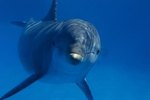
Manatees (Trichechus spp.) are herbivorous marine mammals closely related to elephants. They have large and unwieldy appearances that belie smooth, fluid and measured swimming skills. Manatees spend 100 percent of their lives in the water, and as a result, possess several handy adaptations for succeeding in those locales.
Manatee Basics
Nicknamed "sea cows," mature manatees generally grow to between 18 and 13 feet in length, with typical weights of between 440 and 1,300 pounds. It isn't uncommon to spot manatees all by themselves, but they also frequently spend time in duos or tiny social units of no more than six specimens. Their dense skin is deep gray in color, with barely any hair. The genus Trichechus consists of just three species of manatees. In nature, they often survive for around 40 years.
Heart Rate
When manatees plunge their bodies into the water, their heart rate isn't as fast as it normally is. This adaptation serves a specific function -- to help them save precious oxygen.
As sea mammals, taking in oxygen from the top of the water is absolutely crucial for manatees. When they're swimming and going about their normal activities, they have to rise to the top every three or four minutes. In times of relaxation, however, manatees can stay underwater for a maximum of 15 to 20 minutes, because a lower heart rate consumes less oxygen.
Restoring Breath
When manatees take merely one breath, they switch out the bulk of all of the air circulating in their lungs -- around 90 percent. People, on the other hand, only manage roughly 10 percent. When it comes to switching out air rapidly, manatees are ahead of all of their fellow mammals. Note, too, that manatees respire exclusively via their noses, never orally. All of this allows them to stay underwater for more extended stretches of time.
Nostrils
When manatees submerge themselves in H20, their nostrils seal themselves shut extremely securely. Once they rise to the top again to get some air, their nostrils rapidly and immediately reverse the shutting. (See References 1)
Hemi-Diaphragms
A manatee's body is equipped with helpful hemi-diaphragms. "Normal" diaphragms separate an animal's body into two compartments. Hemi-diaphragms, on the other hand, function as a pair of them, traveling alongside their trunks. This grants both of their lungs the ability to switch air out independently. If a single manatee lung was harmed due to being accidentally struck by a passing yacht, for example, he can manage fine just as long as the other lung was totally unaffected.
References
Photo Credits
-
Comstock Images/Comstock/Getty Images




